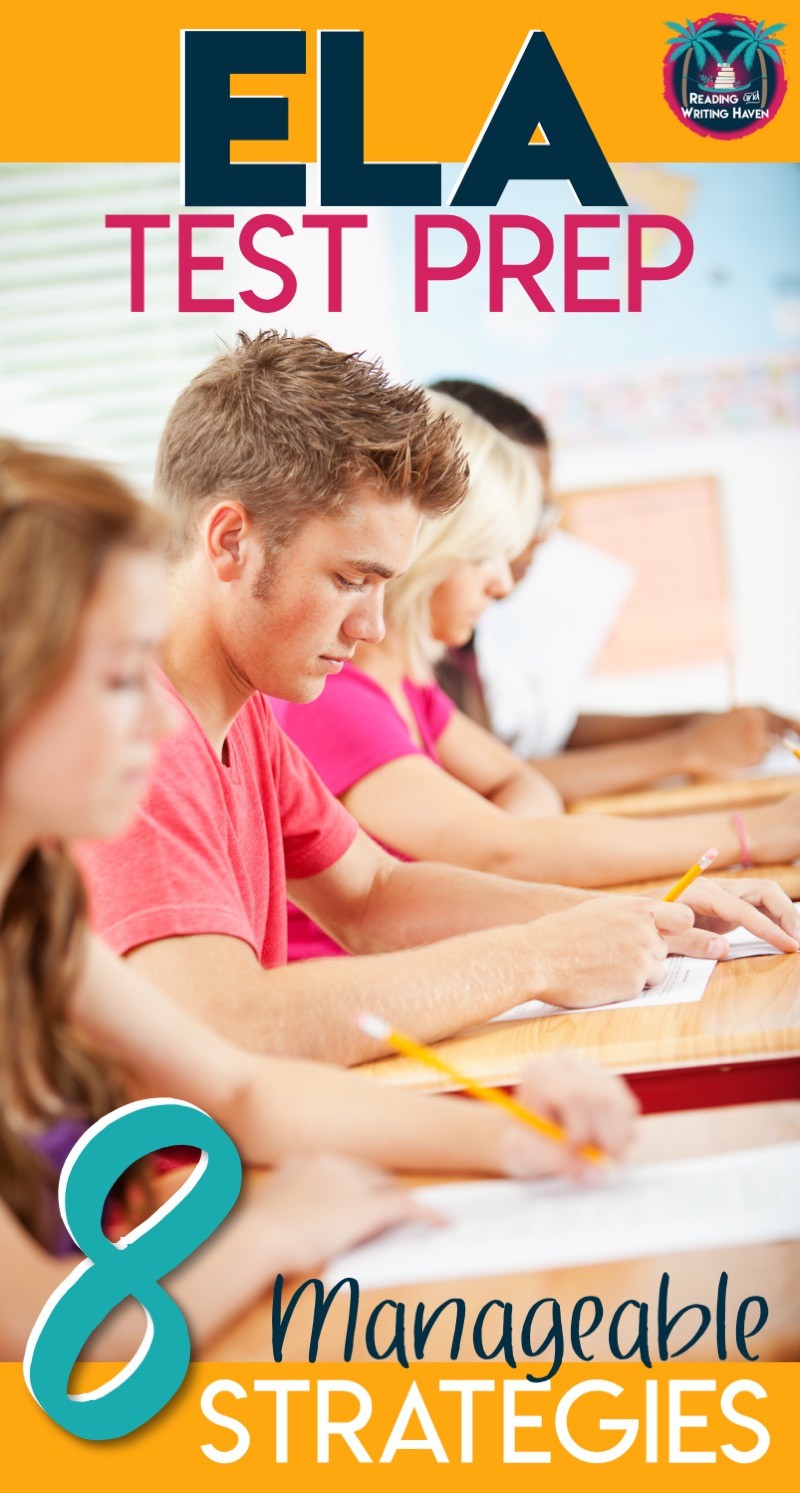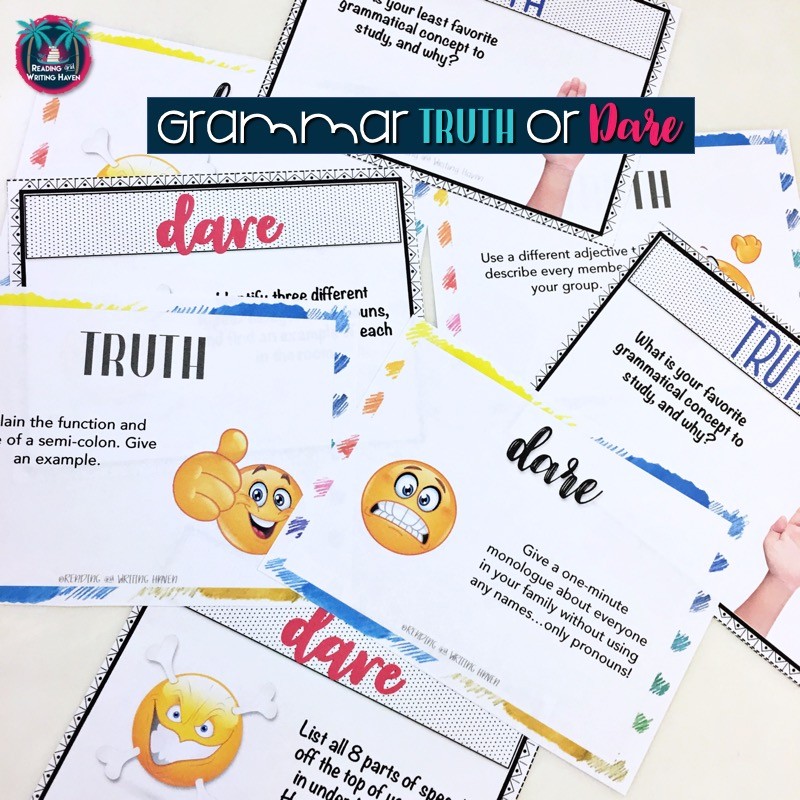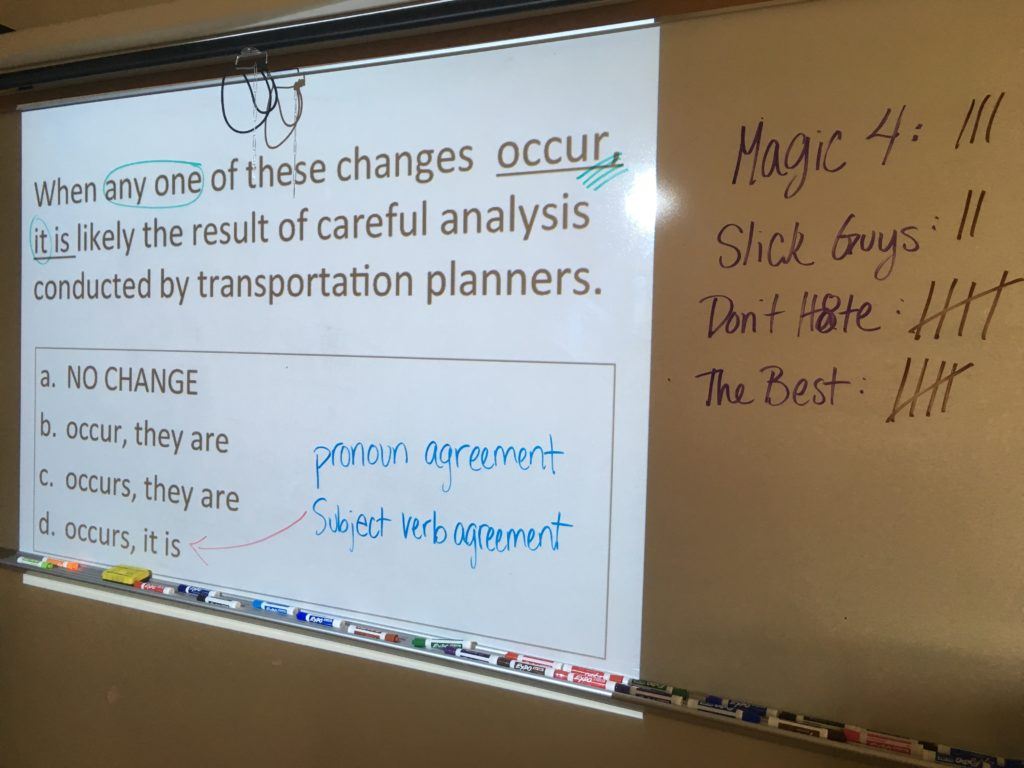8 Manageable ELA Test Prep Strategies
One of the most stressful parts of teaching ELA is standardized test prep. Preparing students to succeed on a standardized test can be frustrating on many levels. Still, teachers as a whole have resolve, passion, and tenacity. We are determined to help our students succeed by preparing them – and well! – in advance. ELA test prep is not something we can cram in last minute. But, we can set students up for success during the window before testing begins. These strategies can help.
1. GET ORGANIZED
The key to test prep for my students has always been to help them get organized with their studying and their exam schedule. One of the first things I do is print out a blank calendar for the month of their exams. (Easy to find blank calendars online.) As a class, we fill in the calendar with important school and exam dates… and then collaboratively we develop a study schedule.
Actually going through the process of writing out a study plan and reviewing study tips and tricks helps to put my students at ease. Once my students see their plan written out on paper, it seems to alleviate some of their stress, and they can then get down to studying. As the exam date approaches, I make sure to check in with my students and ensure that they’re sticking to their study plan.
Here’s a FREE study strategy activity that can be used with ANY subject. (Addie Williams)
2. THINK ALOUD FIVE CORNERS
I like to get students on their feet when we’re working on strategies for multiple choice questions. The weaker readers in the room need to hop inside the brains of the stronger readers, so we do Think Aloud Five Corners. I give students five to ten multiple choice questions to deal with independently under timed conditions. All questions must be answered, even if that means eliminating one answer choice and guessing. Students then stand together in the center of the room, and when I call out “Number 1!,” each student moves quickly to one of five letters, A-E.
Within each small group of students, then, a discussion has to take place. Why did we choose this answer? What text can we offer to defend that answer? In order to keep everyone engaged, I choose the speaker for each group. That way, everyone is responsible.
In the course of dealing with each letter, students may move groups at any time. They quickly learn that an answer that cannot be defended cannot be correct. When we get down to the last two teams (the correct answer and the foil–that tricky one that is almost correct), the class holds a debate, and this time each team chooses its spokesperson. This way, the whole class gets to hear two strong thinkers explain their reasoning. Finally, I give the correct answer and record the students who are in the right group.
Here are the multiple choice resources I like to use with this game. (Angie Kratzer)
3. TARGETED MINI-LESSONS
My favorite way to make test prep manageable in high school is to approach it like I do writing workshop by beginning with targeted mini-lessons. First, I like to take a particular skill (such as parallel structure) and have students complete a mini-lesson through sentence imitation. Then, I have students practice using the skill by applying it to reading and writing before we do any overt test prep. After teaching a lesson around a specific skill, we then work through 2-3 multiple-choice style questions that all involve the targeted skill from the mini-lesson.
Breaking standardized tests down into targeted skills makes it more manageable for students rather than working through practice tests that assess a myriad of different skills. It’s just too much to consume all at once. So, it basically comes down to teaching a skill just like you teach all other skills– scaffold it, model it, and transfer it to a new situation.
Here is a nonfiction close reading activity for Lincoln’s “Gettysburg Address” with multiple choice questions for test prep. (The Bespoke ELA Classroom)
4. WEEKLY PRACTICE WITH TRASHKETBALL
Teachers of high school juniors know that preparing their students for success on college entrance exams is a vital component of classroom instruction. In my American Literature classes, students complete weekly practice for the SAT. At the beginning of the semester, student exercises focus on the multiple-choice questions in the writing and language section of the test. For their Wednesday warm ups, I give students 5 – 10 questions from College Board practice tests.
Over time, students recognize the most commonly tested grammar rules. Some of these include errors with subject and verb agreement (particularly with intervening phrases), commas in nonrestrictive clauses, pronoun and antecedent agreement, and run-on sentences.
The warm-up activities are non-threatening to students since their responses are not graded for correctness, but rather, for their effort and participation in discussion. Students have five minutes to complete the warm ups, and then we discuss the answers in whole-class discussion. To complement these warm ups, I provide focused grammar instruction on the same concepts that students encounter on the SAT.
In these lessons, I teach students the “language” of language. For instance, to help students correct comma splices, they must first understand parts of sentences including subjects, predicates, main clauses, and coordinating conjunctions. To make these lessons more memorable, I often provide trashketball review games as guided practice. It’s amazing how these games make learning grammar and preparing for standardized assessments more engaging!
These are the trashketball games I like to use with ELA test prep. (OCBeachTeacher)
5. PROCESS OF ELIMINATION
Sometimes it’s difficult to choose the right answer on a standardized test. Students will become frustrated and choose any answer just to get done with the test. I always tell my students, “Even if you don’t know the right answer, see if you can figure out the wrong answers.” This is called The Process of Elimination.
The students will make one of three choices during this process: 1) Slash (/) through answers that are definitely wrong (Hint: Almost every question has one answer that is obviously wrong.), 2) Put a question mark (?) by any answer that could possibly be correct (Don’t be too quick to rule something out.), and 3) Put a check mark by any answer that is correct.
Sometimes the students will end up with more than one check mark. That’s just fine. Then the student will choose the answer they believe best answers the question and circle it.
I make my students use Process of Elimination on EVERY multiple choice test, and I have seen a dramatic increase on their scores as opposed to tests where I do not require it.
These are my standardized writing test crash courses for middle school and high school. (Write On! with Jamie)
6. REVIEW TEST-TAKING STRATEGIES
Students need to know that questions and answers are intentionally written to be tricky. Some answer choices may be true but do not answer the question. Other answer choices may only be partially true.
I usually spend at least one day on a lesson teaching strategies for answering multiple choice questions and constructed response prompts before I give students full practice passages on which to try out the strategies. I have students take notes on the different “tricks” they may see in questions and answer choices, and strategies they can use to work through them.
This is the tool I use to teach standardized test strategies, multiple-choice questions, and constructed responses. (The Literary Maven)
7. STATIONS AND STUDENT-LED GAMES
Much of ELA test prep must be teacher led. In order to make sure students truly understand the format, environment, and structure of the test, teachers must lead them in review sessions. Yet, too much teacher-directed test prep can lead to burnout for both the instructor and the students. It’s okay to keep it light and take a class period to let students circulate through some station activities.
Test prep stations can be organized so that each group practices the same skill in a different format, or they can be more diverse (e.g. – one for reading, one for writing, and one for grammar). To fill the stations, you can use task cards, worksheets, short instructional video clips, and practice quizzes, just to name a few options.
When I run stations, I always try to let my students play some sort of game if I can do so in a meaningful way. Games often encourage students who are typically withdrawn and disinterested to engage in course content. They also force students to think harder than usual and ask questions when confused. When the teacher is the sage on the stage, they can easily sit back and passively wait for the answer.
Games prompt students to take control and drive their own learning. Plus, the teacher has the opportunity to listen for misunderstandings and either conduct an on-the-spot mini-lesson or plan a more detailed review for the following day.
One of my favorite ELA test prep games is Grammar Truth or Dare. (Reading and Writing Haven)
8. WHOLE-CLASS GAMES
After a few lessons with the usual test prep material, I lead the class in a game or two using PowerPoint. Standardized tests often rely on a multiple-choice format that is perfect for me to create and project quizzes using questions and answers strait from the practice tests.
I have the students work in small groups of two or three to encourage collaboration and discussion about the questions. I want them to work through these with another set of eyes and another sounding board for their ideas. Each group has one whiteboard and a dry erase marker to write and hold up their answer after the allotted time passes.
If you don’t have white boards you can use four sheets of paper with pre-drawn A, B, C, and Ds on them which students can raise. Bonus – I reveal the answer then use the white board to mark up the question and explain the right answer (or have a student do it). I also keep score on the front to keep the competition lively. (Engaging and Effective)
Visit Engaging and Effective Teaching’s blog for more ELA teaching ideas.
Test prep in secondary ELA can be manageable. Try using these strategies to alleviate some of your stress. Looking for more ELA test prep ideas? You can follow my Pinterest board where I collect all my favorite ideas.
[sc name=”mailchimp1″]



